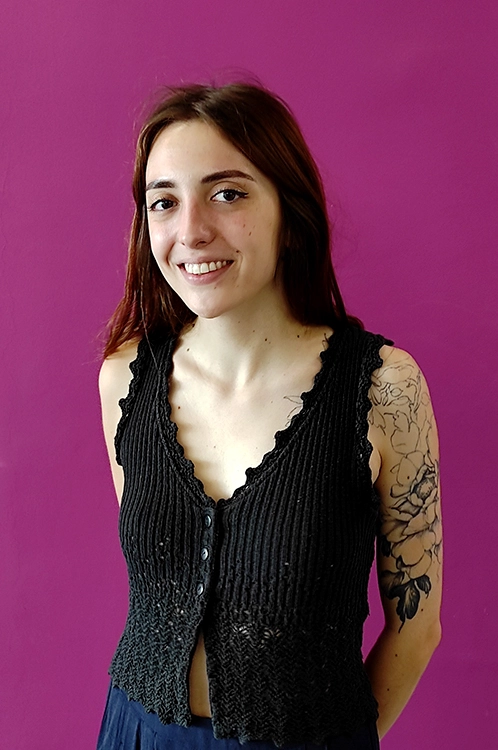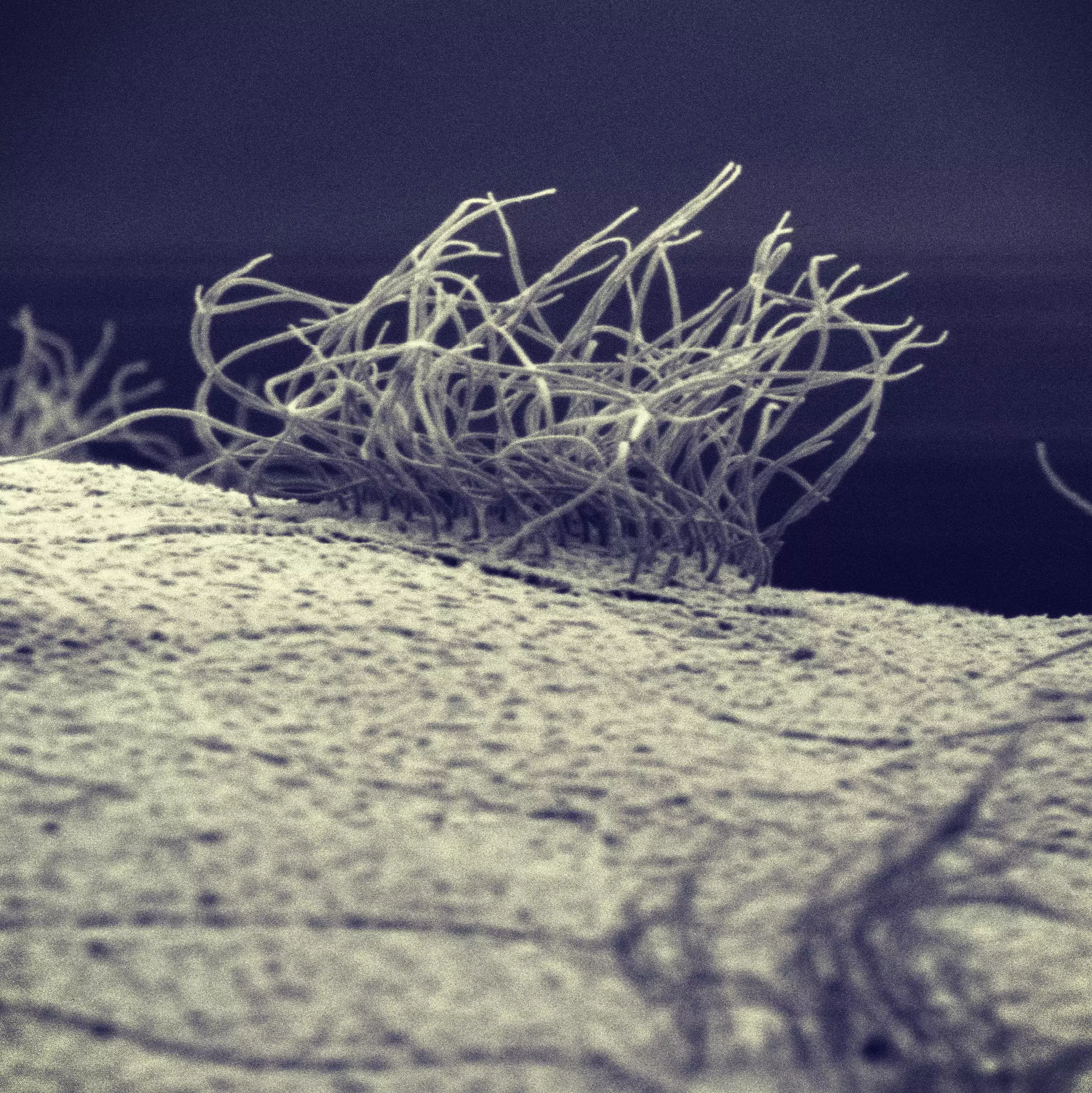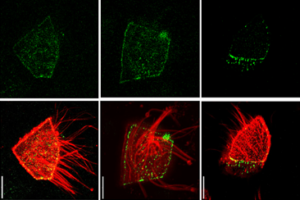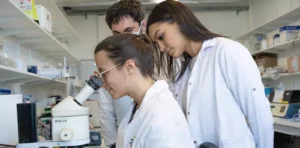Biologie des épithéliums ciliés
Notre objectif est d'élucider les mécanismes moléculaires et cellulaires qui sous-tendent l'assemblage et la fonction des épithéliums ciliés chez les vertébrés
Chez tous les vertébrés, les tissus ciliés spécialisés sont recouverts de cellules abritant des dizaines de cils mobiles, battant de manière coordonnée pour générer un flux de fluide directionnel. Les cellules multiciliées aident au nettoyage des voies respiratoires, à l’implantation des ovules et à la circulation du liquide céphalo-rachidien.
Ainsi, plusieurs pathologies humaines causées par des défauts ciliaires se caractérisent par une détresse respiratoire chronique, des anomalies cérébrales et une fertilité réduite. Cependant, la biologie des cellules multiciliées reste mal comprise, en raison de la rareté des modèles in vivo accessibles. Notre équipe étudie la peau embryonnaire de l’amphibien Xenopus laevis, ce qui s’avère très puissant pour révéler les principes moléculaires et cellulaires de la multiciliogenèse conservés chez l’homme.
L’embryon de Xenopus laevis se prête facilement à la manipulation des gènes codant pour les protéines ainsi que des ARN non codants (microARN, longs ARN non codants) par micro-injection de constructions ARNm ou de morpholinos antisens, dès la fécondation. L’épiderme cilié est particulièrement adapté à l’analyse fonctionnelle car il peut être ciblé spécifiquement et se trouve à la surface de l’embryon, ce qui facilite l’imagerie par microscopie optique et électronique. Ce tissu peut également être facilement exposé à des composés pharmacologiques et à des protéines recombinantes à différents stades de son développement, et soumis à la transgénèse pour tracer et manipuler les différents types de cellules qui le composent.
Publications
Lrrcc1 and Ccdc61 are conserved effectors of multiciliated cell function
The Scf/Kit pathway implements self-organised epithelial patterning
CDC20B is required for deuterosome-mediated centriole production in multiciliated cells
BMP signalling controls the construction of vertebrate mucociliary epithelia
Control of vertebrate multiciliogenesis by miR-449 through direct repression of the Delta/Notch pathway
A vertebrate Vangl2 translational variant required for planar cell polarity
Lrrcc1 and Ccdc61 are conserved effectors of multiciliated cell function
A live-imaging protocol to track cell movement in the Xenopus embryo
The Scf/Kit pathway implements self-organised epithelial patterning
ECT2 associated to PRICKLE1 are poor-prognosis markers in triple-negative breast cancer
CDC20B is required for deuterosome-mediated centriole production in multiciliated cells
Notch1 is asymmetrically distributed from the beginning of embryogenesis and controls the ventral center
A Bioresistant Nitroxide Spin Label for In-Cell EPR Spectroscopy: In Vitro and In Oocytes Protein Structural Dynamics Studies.
Animal multicellularity and polarity without Wnt signaling.
Nodal/Activin Pathway is a Conserved Neural Induction Signal in Chordates
Nodal–Activin pathway is a conserved neural induction signal in chordates
Lineage commitment of embryonic cells involves MEK1-dependent clearance of pluripotency regulator Ventx2.
Planar cell polarity in ciliated epithelia.
MicroRNAs as key regulators of GTPase-mediated apical actin reorganization in multiciliated epithelia
Identification of p62/SQSTM1 as a component of non-canonical Wnt VANGL2-JNK signalling in breast cancer.
The PTK7 and ROR2 Protein Receptors Interact in the Vertebrate WNT/Planar Cell Polarity (PCP) Pathway
miR-34/449 control apical actin network formation during multiciliogenesis through small GTPase pathways
BMP signalling controls the construction of vertebrate mucociliary epithelia
Induction and Differentiation of the Xenopus Ciliated Embryonic Epidermis.
Dysregulation of Wnt Inhibitory Factor 1 (Wif1) expression result in aberrant Wnt-β-catenin signaling and cell death of the cloaca endoderm, and anorectal malformations.
Xenopus embryonic epidermis as a mucociliary cellular ecosystem to assess the effect of sex hormones in a non-reproductive context.
On the Origin and Evolutionary History of NANOG.
A gene regulation network controlled by Celf1 protein-rbpj mRNA interaction in Xenopus somite segmentation.
The human PDZome: a gateway to PDZ mediated functions.
Ventx factors function as Nanog-like guardians of developmental potential in Xenopus.
An essential role for transcription before the MBT in Xenopus laevis.
MicroRNA-based silencing of Delta/Notch signaling promotes multiple cilia formation.
Control of vertebrate multiciliogenesis by miR-449 through direct repression of the Delta/Notch pathway
MicroRNA control biosynthesis of motile cilia in vertebrates.
PTK7: a cell polarity receptor with multiple facets.
Protein tyrosine kinase 7 has a conserved role in Wnt/β-catenin canonical signalling.
Distinct Xenopus Nodal ligands sequentially induce mesendoderm and control gastrulation movements in parallel to the Wnt/PCP pathway.
BMP inhibition initiates neural induction via FGF signaling and Zic genes.
Wnt inhibitory factor 1 is epigenetically silenced in human osteosarcoma, and targeted disruption accelerates osteosarcomagenesis in mice.
Neural induction in Xenopus requires early FGF signalling in addition to BMP inhibition.
Role of Siamois before and during gastrulation. In Gastrulation : From cells to embryo
Siamois functions in the early blastula to induce Spemann’s organiser.
A study of Xlim1 function in the Spemann-Mangold organizer.
A new secreted protein that binds to Wnt proteins and inhibits their activities.
Embryonic induction: is the Nieuwkoop centre a useful concept?
A role for the vegetally expressed Xenopus gene Mix.1 in endoderm formation and in the restriction of mesoderm to the marginal zone.
Mutations in ccf, a novel Drosophila gene encoding a chromosomal factor, affect progression through mitosis and interact with Pc-G mutations.
The homeobox gene Siamois is a target of the Wnt dorsalisation pathway and triggers organiser activity in the absence of mesoderm.
Actualités
Lost in translation: Vangl2 short and long
La traduction commence par une Méthionine: Vrai, mais pas toujours, comme le montre une étude sur Vangl2.
Fais ton stage à l’IBDM !
Tu es à la recherche de ton stage de Master ? L’IBDM te semble être le bon endroit pour le faire ? Découvre nos offres dès maintenant.
Prix de Thèse 2021 de la Société Française de Biologie du Développement (SFBD) pour Alexandre CHUYEN
Alexandre CHUYEN, qui a préparé sa thèse de doctorat sous la direction d’Andrea Pasini dans l’équipe Kodjabachian a obtenu le Prix de Thèse 2021 de la SFBD.
Une étude publiée dans Developmental Cell par l’équipe Kodjabachian dévoile comment les cellules multiciliées se distribuent à intervalles réguliers dans l’épiderme embryonnaire du xénope.
The selected candidate will receive training in the following areas: molecular biology, cell biology, Xenopus micro-injection and micro-surgery, fluorescent confocal microscopy, video-microscopy, numerical image analysis.
















